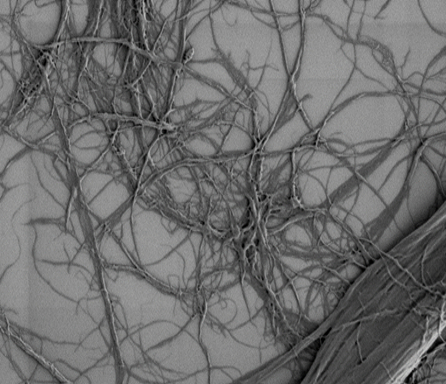
Comparison of Microfibrillated cellulose and Nanocrystalline cellulose
Inger Mari Nygård Vold | December 27, 2016
Cellulose is a renewable and sustainable material and is one of the most abundant natural polymers on earth. Traditionally, cellulose materials have been sold either as a material at the fiber level or as modified celluloses at the molecular level. Currently, there is a high interest in utilizing the full potential of cellulose, and development and commercialization of cellulose materials possessing other structural dimensions are continuously progressing. Microcrystalline cellulose (MCC) has been used commercially for decades. In recent years, the scientific work has focused mainly on two different types of celluloses; microfibrillated cellulose (MFC) and nanocrystalline cellulose (NCC).
In a previous blog post, I was focusing on the differences and similarities between MFC and MCC. In this continuation blog post, I will give you a comparison of MFC and Nanocrystalline cellulose (NCC).
Production and morphology
Native cellulose fibers are composed of cellulose molecules which are aggregated into fibrils, fibril bundles and finally into cellulose fibers. The fibrils contain both crystalline and amorphous regions. MFC and NCC are produced by revealing these basic structural building blocks by various processing methods. The final morphology and properties of MFC or NCC produced are very dependent on the raw materials used and the process for production, leading to materials with different properties. That means that there is a large variety of properties also within the MFC term and NCC term.
Referring to my previous blog post on MFC and MCC: Where does NCC fit in? Nanocrystalline cellulose is a crystalline cellulose product which is most closely related to microcrystalline cellulose. They are both produced by an initial hydrolysis step removing the amorphous parts giving short rod-like fibrils of high crystallinity. The type of acid used during the acid hydrolysis step is important for the final product properties. MCC products are mostly produced by use of hydrochloric acid, whereas sulfuric acid is mainly used in the production of NCC. Sulfuric acid hydrolysis results in negatively charged NCC due to sulfate ester groups created on the fibril surfaces during the hydrolysis step. The negative charges of NCC will stabilize the aqueous suspensions, whereas NCC produced by hydrochloric acid do not disperse as readily, and tend to flocculate in aqueous suspensions. There is a general opinion that microcrystalline cellulose has larger fibril dimensions compared to nanocrystalline cellulose, but there are no clear limits between the two terms, and many products could probably be recognized both as MCC and NCC.
MFC products, on the other hand, are produced with no acid hydrolysis step, making it possible to retain both the crystalline and amorphous regions and conserving the molecular mass of cellulose. This results in a product characterized by relatively long and thin interconnected fibrils with a heterogeneous distribution of internal dimensions. The length and flexibility of the fibrils are one of the main features that differentiate MFC from NCC.

Microfibrillated cellulose (Exilva, Borregaard) consists of long and thin fibres which are tied to a three dimensional network.

Transmission electron micrograph of cellulose nanocrystals from ramie. Compared to MFC, the fibers are shorter and not interconnected to each other (source of the picture: Cellulose-reinforced composites: from micro-to nanoscale by Alain Dufresne and Mohamed N. Belgacem, licensed under a Creative Commons Attribution License)
Physical properties and functionalities
Microfibrillated cellulose and nanocrystalline cellulose are both insoluble in water and have a high aspect ratio and high surface area compared to traditional cellulose fibers. This makes both products promising in a wide range of applications, including among others, coatings, adhesive, paper and packaging. In aqueous suspensions they will create particulate fibril networks, but due to the structural differences the properties of these networks differ.
MFC consist of long interconnected fibrils, and the resulting flexible MFC particle creates a stronger network with higher efficiency compared to NCC. This is illustrated by the fact that MFC has high viscosity and yield stress, it is shear thinning and has high water holding capacity. NCC, on the other hand, consists of short and stiff rod-like particles creating a much weaker network with lower viscosity and yield strength than MFC, and it is not as good at holding water. Whereas the particle dimensions of MFC restricts alignment of the fibrils, NCC exhibits self-assembly and birefringence, and in concentrated suspensions, NCC arranges as a chiral nematic liquid crystal.
The negatively charged sulfate ester groups on the surface NCC will stabilize the aqueous suspensions of NCC, but will also impact on the stability and tolerance towards changes in e.g. pH, ionic strength and temperature in the system and the final applications. Both MFC and NCC have impressive mechanical properties. The mechanical properties are dependent on both the crystalline and amorphous regions. As NCC is a more crystalline material, the mechanical properties will be different from MFC which comprises both crystalline and amorphous areas.
As you have seen in the two blog posts comparing MFC with MCC and NCC, both fibrillar and crystalline cellulose products have highly attractive properties, giving a broad range of potential uses. In the end, it is the desired function in a particular product formulation that will determine which product type has the most beneficial properties for your needs. Both cellulose families will give you a great opportunity for developing new formulations in the field you are working in, contributing with novel properties and a green profile into your product development.
Written by:
Inger Mari Nygård Vold
